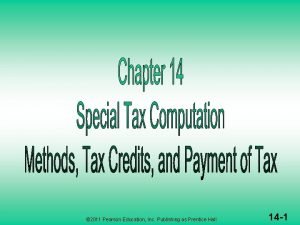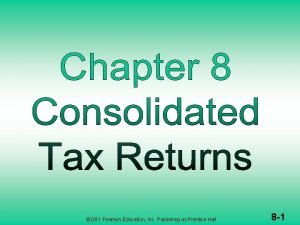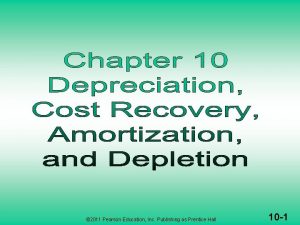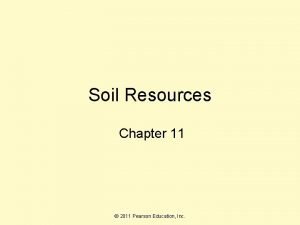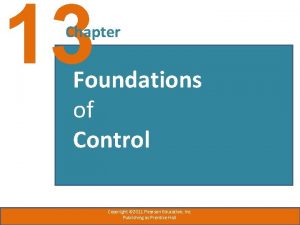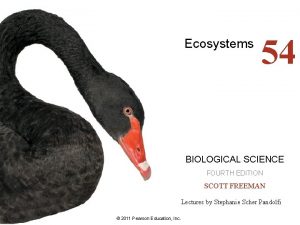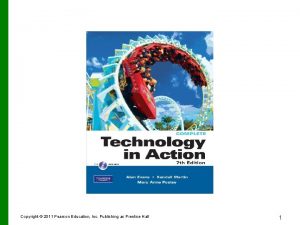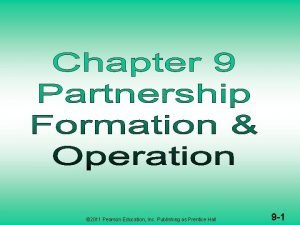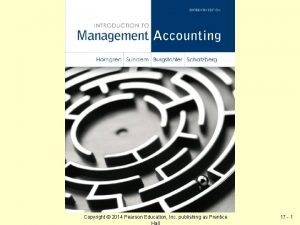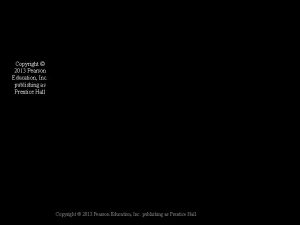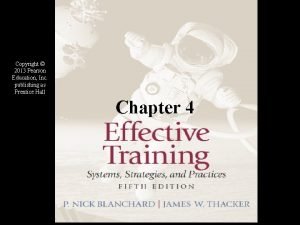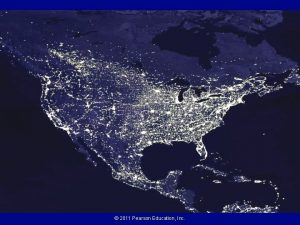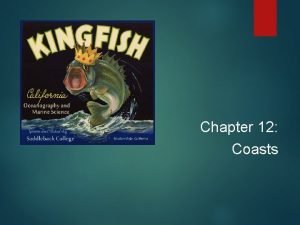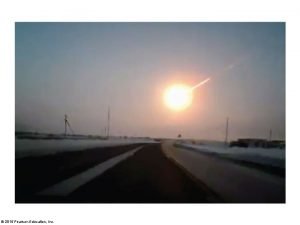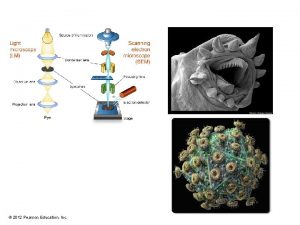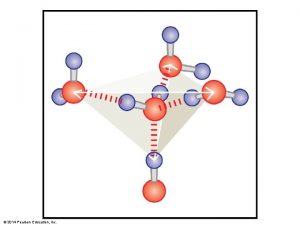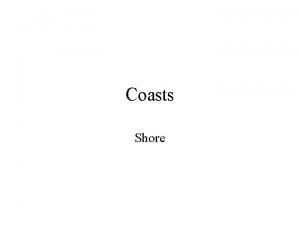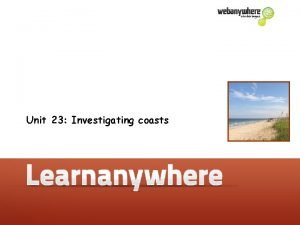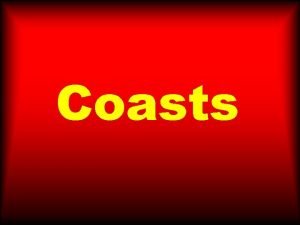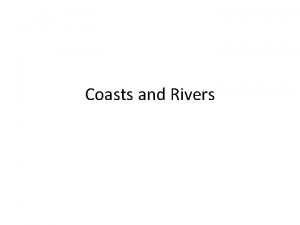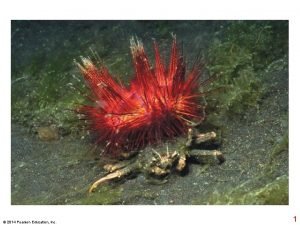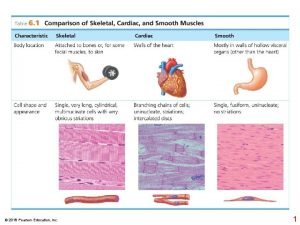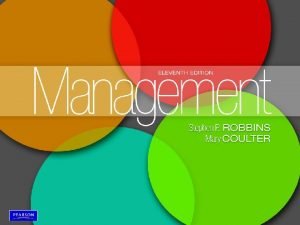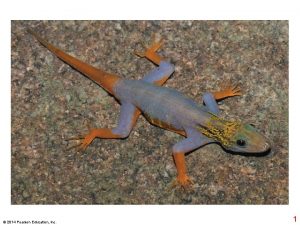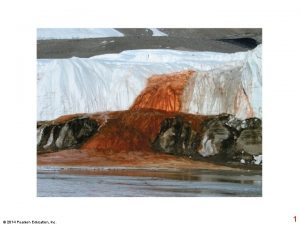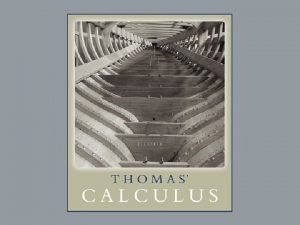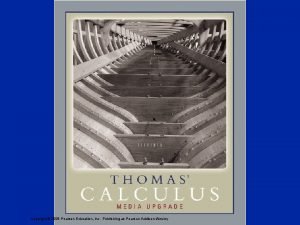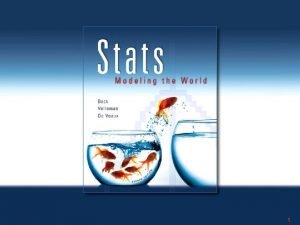Changing Coasts Chapter 9 2011 Pearson Education Inc





































- Slides: 37

Changing Coasts Chapter 9 © 2011 Pearson Education, Inc.

You will learn • The major coastal processes, including waves, currents, tides, and sea level change, and how they work • The characteristics of the most common types of landforms along coasts, including beaches, estuaries, bays, and headlands • What causes coastal erosion, how it happens, and what change it creates • What causes coastal sedimentation, how it happens, and what change it creates • The role of storms in changing coasts • How people attempt to respond to changes caused by flooding, erosion, and sedimentation along coasts © 2011 Pearson Education, Inc.

© 2011 Pearson Education, Inc.

Coastal Basics • Measuring waves – – – Wave height Crest (peak) and trough (lowest point) Wavelength Period Velocity • Size of waves generated on the open water depends on: – Wind strength – Duration of wind blowing in a consistent direction over water surface – Distance over which the wind blows (called the fetch) © 2011 Pearson Education, Inc.

Wave Properties Figure 9 -5 Wave Properties Height (the vertical distance from a crest to an adjacent trough) and wavelength (the horizontal distance from one crest or trough to the next) are fundamental properties of a wave. © 2011 Pearson Education, Inc.

Waves in Deep and Shallow Water Figure 9 -6 In deep areas, movement of water within a wave is circular, but the size of the circle decreases downward to a depth of about half a wavelength. As waves approach shore and reach areas where the water depth is less than half a wavelength, movement within the wave becomes increasingly elliptical. Slowed by friction with the bottom, the troughs travel more slowly than the crests, causing the wave’s height to increase and its wavelength to decrease. © 2011 Pearson Education, Inc.

Wave Refraction Figure 9 -8 Waves that approach shore obliquely undergo refraction, becoming more parallel to the shoreline as friction slows the parts of the waves that enter shallow water first. (b) Refraction focuses wave energy on headlands, resulting in conversion of the headland into an island. © 2011 Pearson Education, Inc.

Nearshore Currents • Longshore drift—movement of sediment by longshore currents – Waves wash up the face of the beach at an angle, carrying sediment up the shore – Water washes back down the slope of the beach, carrying sediment grains directly back to the shore - Beach drift—movement of sediment along the shore – These longshore currents also transport sediment along the coast • Rip currents—plume-shaped currents conveying the water from breaking waves back through the surf zone – Uprush—water flows up the beach in a turbulent sheet – Backwash—flows of water backward towards ocean © 2011 Pearson Education, Inc.

Longshore Drift Figure 9 -9 Waves that approach the shore obliquely create longshore currents parallel to the beach that can transport sediment along the coast. They also move sand grains in a zigzag motion along the beach. © 2011 Pearson Education, Inc.

Tides • Sea level fluctuates between 2 high and 2 low tides each day – Caused by gravitational interactions among Earth, Moon, Sun – But especially between Earth and the Moon • Tidal range—amount of rise and fall during a tidal cycle – Varies from day to day – Varies due to location of the Moon relative to Earth and the Sun • Spring tides— 2 times in lunar month that tidal ranges are greatest • Neap tides—when tidal ranges are the least – Influenced by the shape of the coast and seafloor • Coastal currents—where tides flow through restricted channels – Tidal currents • Erode the seafloor • Transport sediment © 2011 Pearson Education, Inc.

Figure 9 -11 Tides (a) When Earth, the Moon, and the Sun are aligned, the combined gravitational pull of the Moon and Sun give rise to especially high and especially low tides. (b) When the three bodies form a right angle, the tides are smaller. (Note that the sizes of the tidal bulges in both parts are greatly exaggerated. ) © 2011 Pearson Education, Inc.

Sea Level Change • Global sea level change – Global climate has fluctuated—due to variations in amount Sun’s radiation the Earth receives • Changes in Earth’s orbit around the Sun • Transfer of water between oceans and polar ice accumulations – Recent warming— 15 cm (6 in) rise in sea level the last 100 years • Local sea level changes – Movements of the geosphere’s exposed surface • Move up or down • Gradual – Loading and unloading of weight on the geosphere’s crust • Fast – Commonly tied to plate tectonic movements © 2011 Pearson Education, Inc.

Sea Level during the Last Glaciation Figure 9 -15 Large ice sheets covered Canada and parts of the northern United States during the last glacial maximum 20, 000 years ago. Shorelines were about 110 to 125 meters lower than today, and much of the Gulf of Mexico and Atlantic continental shelves were exposed plains with rivers and forests. © 2011 Pearson Education, Inc.

Coastal Features • The Atlantic coast • Formed from rifting and seafloor spreading • • • = passive continental margin subsides as seafloor spreading opens its bordering ocean sediment derived from the continent gradually accumulates interplay of subsidence, sea level change, and sediment supply Northeast Atlantic coast • continental ice sheets scraped the land down to bedrock • ice melted and sea level rose ( 20, 000 and 7000 years ago) • submerged bedrock—forming rocky cliffs, headlands, and islands • Southern New England • ice sheets transported sediments from continental interior • deposited them to form a thick apron of sediment • rising sea eroded glacial sediment and formed bluffs with beaches © 2011 Pearson Education, Inc.

A Passive Continental Margin Figure 9 -17 Small changes in sea level can cause shorelines to advance (transgress) or recede significant distances on gently sloping shelves and coastal plains of passive continental margins. (Note that the slope of the continental margin is actually much more gradual than it appears here). © 2011 Pearson Education, Inc.

Coastal Features • New Jersey to Florida – Slopes gently to the sea on coastal plain • Merges with the continental shelf – Barrier islands • Long, low-lying ridges of sand gravel • Isolated from the mainland by shallow lagoons, bays, or marshes • Bays or inlets separate the individual islands or spits • Formed during the last 6000 or 7000 years – Sea level slowly rising or fluctuating at levels like today – Former river valleys drowned by rising sea level • Evolve into semienclosed coastal bays, or estuaries • Freshwater from rivers mixes with seawater (e. g. , Chesapeake Bay) © 2011 Pearson Education, Inc.

Chesapeake Bay: A Drowned River Valley Figure 9 -20 Chesapeake Bay, the largest estuary in the United States, formed as rising sea level flooded the Susquehanna River Valley. © 2011 Pearson Education, Inc.

The Mississippi Delta Figure 9 -24 The huge delta of the Mississippi River (a) is a myriad of streams and islands where the biosphere and hydrosphere intimately mix (b). © 2011 Pearson Education, Inc.

Coastal Features • The Pacific coast – Very active tectonically • transform and convergent plate boundaries • coastal California—influenced by San Andreas Fault system • coastal NW—influenced by Cascadia subduction zone • narrow continental shelf and irregular – rocky cliffs and headlands separated by pocket beaches – sea caves, sea arches, sea stacks – large beaches – rivers bring abundant sediment to the coast © 2011 Pearson Education, Inc.

Erosional Features and Sea Level Rise on Coasts Figure 9 -25 The Sea as Sculptor Erosion on the rocky Oregon coast creates sea arches, sea stacks, headlands, and pocket beaches. Figure 9 -27 Pacific Estuary Estuaries along the Pacific coast are river valleys drowned by rising sea level. © 2011 Pearson Education, Inc.

Coastal Features • The Alaska coast • SE—transform plate boundary (the Fairweather fault system) • narrow continental shelf and rugged rocky coasts • rising sea level creates islands, protected waterways • Eastern Gulf of Alaska coast—collision of Yakutat block with Alaska • emergent coastline • coastal plain, raised beach ridges, wave-cut terraces, sandy beaches • S—convergent plate boundary • one of the longest subduction zones in the world (Aleutian Island arc) • both emergent and submergent coastlines • Bering Sea—tectonically isolated • broad continental shelf; barrier islands; long beaches • headlands and sea cliffs • Arctic coastline—passive continental margin • wide coastal plain, barrier islands, and river mouth deltas © 2011 Pearson Education, Inc.

The Alaska Coast Figure 9 -28 Large parts of the Bering Sea shelf are less than 100 meters (330 ft) deep. The connection between the Bering Sea and the Arctic Ocean was created when sea level rose between 20, 000 and 7000 years ago. © 2011 Pearson Education, Inc.

A Closer Look at Beaches • Beaches—“accumulations of loose water-borne material (generally sand pebbles, often accompanied by mud, rocks, and shell fragments) deposited on the edge of a body of water—typically a gently sloping shore washed by waves or tides. ” • The influences of atmosphere (wind), hydrosphere (waves), and geosphere (shoreline) come together at the beach • Beach anatomy – – – sea cliff, bluff, or dune berm beach face nearshore zone surf zone ongshore bar © 2011 Pearson Education, Inc.

Beach Anatomy Figure 9 -29 Distinctive parts develop on beaches as waves and winds come ashore under different conditions. The stronger waves and winds during storms are particularly effective at developing berms and dunes. © 2011 Pearson Education, Inc.

A Closer Look at Beaches • Beach materials – quartz – seashells or coral—tropical – eroded and weathered volcanic rock (Hawaiian black sand) • Sediment supply – littoral cells—self-contained system—sediment enters or exits in various ways – sediment budget • credits (sand entering the cell)—rivers, longshore drift, etc. • debits (sand leaving the cell)—wind, ocean currents – when the debits >> credits = erosion – when the credits >> debits = growth © 2011 Pearson Education, Inc.

A Littoral Cell—Sediment transfer Figure 9 -31 The Santa Monica littoral cell is just one of many on the California coast. Sediment that enters this littoral cell is carried along the shoreline and eventually lost to deep water through submarine canyons. © 2011 Pearson Education, Inc.

Coasts and Storms • Hurricanes – Hurricanes are vast rotating storms, some 500 km (310 mi) or more across, which intensify by drawing energy and moisture from the warm surface water of the tropics – Tropical depressions—storms with winds < 62 km/hr (39 mph) – Tropical storms—winds > 62 km/hr—assigned a name – Hurricane—sustained winds reach 118 km/hr (74 mph) • Thunderstorms surround the low pressure center of the storm, forming the eye wall • Eye—area of warm, calm air at the center of the hurricane © 2011 Pearson Education, Inc.

Anatomy of a Hurricane Figure 9 -35 The center of a hurricane is a low-pressure area of warm, calm air, called the eye. It is surrounded by a band of thunderstorms that form the eye wall. As warm, moist air spirals inward toward the eye wall and rises, it begins to cool and its moisture condenses into rain. © 2011 Pearson Education, Inc.

Saffir-Simpson Hurricane Scale Ranks the potential for wind damage and flooding from a hurricane. Rankings are based on: • central pressure within the eye of the storm • maximum sustained winds • potential for a dangerously high storm surge © 2011 Pearson Education, Inc.

Hard Stabilization • Seawalls—massive structures—withstand the full force of storm waves • Bulkheads—smaller vertical walls of timber, concrete, or steel – often placed by berm and backfilled to create a flat surface • Revetments—lighter-duty structures – provide a protective covering on embankments or beaches – protect against erosion by nearshore currents; light wave activity – may increase erosion of the beach fronting the seawall • Breakwaters – breakwaters—barriers built parallel to the coast in the water • cause waves to break offshore instead of onshore – most breakwaters rise above the water surface • provide a calm area behind them for an artificial harbor or port © 2011 Pearson Education, Inc.

Hard Stabilization • Groins—barriers built perpendicular to the shore – To capture sand from longshore drift – Thwart beach erosion or rebuild a beach – Create a positive sediment budget – Usually built in groups, called groin fields • From stone block, concrete, sheet steel, or timber • Jetties—built perpendicular to the shore – Used to stabilize inlets or filling in with sediment – Single jetty may be constructed on the updrift side of the inlet – Jetties may be constructed on both the updrift and downdrift sides • Issue: sediment accumulates on the updrift side of the barrier, erodes from the downdrift side – Redistribution of sediment can cause serious downdrift erosion © 2011 Pearson Education, Inc.

Views of Hard Stabilization Figure 9 -39 (a) A bulkhead: Boston, MA (b) A revetment: Toronto, Canada. © 2011 Pearson Education, Inc.

Groins Figure 9 -41 Groins, used to prevent beach erosion or restore eroded beaches, capture sand from longshore drift on their updrift side. Common saw-tooth pattern formed by sediment accumulation on updrift side. © 2011 Pearson Education, Inc.

Soft Stabilization • Beach nourishment – Sand is brought in to create a new beach – Bulks up the underwater slope of the beach face – Sand size—critical • Difficult to find source of sediment for dredging—usually offshore – Renourished periodically to keep pace with the rate of erosion or periodic storm damage • Dune restoration – Dunes protect natural beaches from storms and high water – Programs seek to either: • Restore damaged dunes • Build new or larger dunes to protect property – Install sand fencing or plant beach grass – Bulldoze sand into a pile; plant vegetation to stabilize it © 2011 Pearson Education, Inc.

Management Practices • Managing sediments – Dredging • Shifting sediment can get deposited in channels • Dredging has to be done to keep navigational channels open – Sediment contamination • Dredging of sediments contaminated with pollutants – Industrial, shipping, or municipal waste disposal activities – The sediment is difficult to carefully recover – Difficult to remediate – Can’t be used for sediment enhancement projects • Mitigating coastal storm hazards – Rigorous building codes to reduce structural damage – Special types of nails or reinforcing metal straps • Coastal zone management © 2011 Pearson Education, Inc.

SUMMARY • Winds move surface and near-surface water to create waves and swells that transfer energy through the hydrosphere. • Waves vary in size and are described by their height, wavelength, and period. • As waves enter shallow water, friction with the bottom causes a wave’s height to increase and its wavelength to decrease. Waves refract and become more parallel to the shoreline. • Longshore drift develops where waves are oblique to the shoreline and move water and sediment along it. • Tides are caused by gravitational interactions of Earth, Moon, and Sun. • Global climate fluctuations can cause changes in sea level. • Movements of the geosphere affect many coastlines. Tectonic movements along plate boundaries have caused both uplift and subsidence on long lengths of coastline. © 2011 Pearson Education, Inc.

SUMMARY (cont. ) • The physical features along coasts vary depending on tectonic setting, local geology and geography, and sediment supply. • Beaches have distinctive parts. The littoral zone is where sediment is in motion along shores. • Erosion occurs where there is a negative sediment budget. • Sediment is deposited where there is a positive sediment budget and where wave and current energy is diminished. • Coastal storms, including hurricanes, have major effects on coasts. • Physical features people construct to control coastal processes have had mixed results. Soft stabilization techniques can help, but over the long term, coastal processes are not very controllable. • Respecting coastal processes and the value of natural coastal resources, such as habitat and ecosystems, will be part of what people do to achieve a sustainable future. © 2011 Pearson Education, Inc.
 2011 pearson education inc
2011 pearson education inc 2011 pearson education inc
2011 pearson education inc 2011 pearson education inc
2011 pearson education inc Friedman rank test
Friedman rank test 2011 pearson education inc
2011 pearson education inc 2011 pearson education inc
2011 pearson education inc 2011 pearson education inc
2011 pearson education inc 2011 pearson education inc
2011 pearson education inc Pearson education inc publishing as pearson prentice hall
Pearson education inc publishing as pearson prentice hall 2011 pearson education inc
2011 pearson education inc 2011 pearson education inc
2011 pearson education inc Pearson education inc. publishing as prentice hall
Pearson education inc. publishing as prentice hall Pearson education 2011
Pearson education 2011 2011 pearson education inc biology
2011 pearson education inc biology 2011 pearson education inc
2011 pearson education inc 2011 pearson education inc biology
2011 pearson education inc biology 2011 pearson education inc
2011 pearson education inc 2011 pearson education inc
2011 pearson education inc 2011 pearson education inc
2011 pearson education inc Pearson education inc publishing as pearson prentice hall
Pearson education inc publishing as pearson prentice hall Pearson education inc publishing as pearson prentice hall
Pearson education inc publishing as pearson prentice hall Pearson education inc publishing as pearson prentice hall
Pearson education inc publishing as pearson prentice hall Pearson education 2011
Pearson education 2011 Copyright pearson education inc
Copyright pearson education inc Copyright pearson education inc
Copyright pearson education inc Copyright by pearson education inc. answers
Copyright by pearson education inc. answers 2017 pearson education inc
2017 pearson education inc 2017 pearson education inc
2017 pearson education inc 2017 pearson education inc
2017 pearson education inc 2017 pearson education inc
2017 pearson education inc Pearson education inc 4
Pearson education inc 4 Pearson education, inc.
Pearson education, inc. 2014 pearson education inc
2014 pearson education inc 2013 pearson education inc
2013 pearson education inc 2013 pearson education inc
2013 pearson education inc Performance gap
Performance gap 2013 pearson education inc
2013 pearson education inc 2012 pearson education inc
2012 pearson education inc









